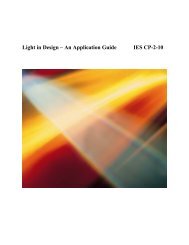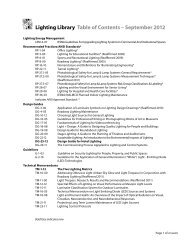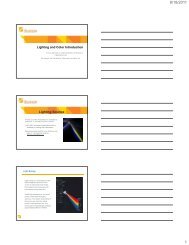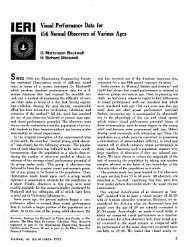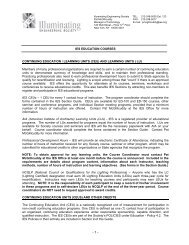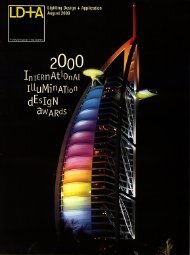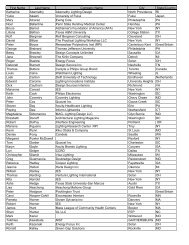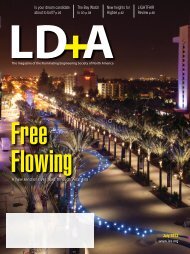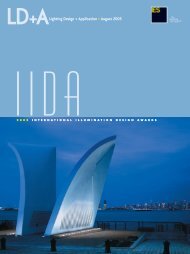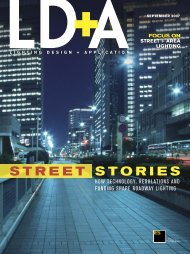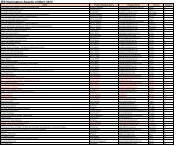Residential Lighting - Illuminating Engineering Society
Residential Lighting - Illuminating Engineering Society
Residential Lighting - Illuminating Engineering Society
Create successful ePaper yourself
Turn your PDF publications into a flip-book with our unique Google optimized e-Paper software.
was in the level of luminance value<br />
beyond which subjects felt discomfort<br />
for all angles. The 1999 study<br />
with lighting professionals reported<br />
a value of 9000 cd/m 2 while the<br />
2000 study showed a 16,000<br />
cd/m 2 value for the naïve subjects.<br />
This suggests that lighting designers<br />
are more sensitive to discomfort<br />
glare than naïve subjects. While<br />
there may be technical debate on<br />
this discrepancy, this much is clear:<br />
for practical applications in longterm<br />
work environments, we need to<br />
consider a level of overhead source<br />
luminance that is much lower than<br />
the BCD values determined in the<br />
studies. This is because we do not<br />
want to design a lighting system in<br />
which only 50 percent of the people<br />
are satisfied. Moreover, this BCD<br />
level is for luminance of the glare<br />
source at 85 degrees. For angles<br />
below 85 degrees, say 55 and 65<br />
degrees, the lamp luminance values<br />
should be much lower.<br />
There was another interesting<br />
finding from this research: the pattern<br />
of the results are exactly what<br />
would be expected from the fundamental<br />
formulae on which the conventional<br />
discomfort glare prediction<br />
systems, such as VCP, Glare<br />
index and the UGR system are<br />
based. As a matter of fact, the<br />
2000 study shows that the approximate<br />
level of discomfort produced<br />
by a glare source between 55<br />
degrees from line of sight and the<br />
edge of the visual field of view can<br />
be predicted using the Unified Glare<br />
Rating system.<br />
Is overhead glare a different kind<br />
of glare No. The research results<br />
imply that overhead glare is simply<br />
an extension of discomfort glare and<br />
not an entirely separate phenomenon.<br />
It confirmed that discomfort<br />
glare does not cease at 55 degrees<br />
from line of sight, but continues until<br />
the glare source passes well outside<br />
the field of view. The data does show<br />
that the luminance required to produce<br />
discomfort glare at very high<br />
angles, i.e., when the it is overhead,<br />
is much higher than is required at<br />
lower angles i.e., when it is closer to<br />
the line of sight. There is no doubt<br />
such luminances are well within the<br />
range of our present day light<br />
sources and luminaires.<br />
When is overhead glare a concern<br />
for lighting designers and engineers<br />
Well, the short answer is<br />
that whenever visual comfort is an<br />
important issue. Take for example,<br />
lighting for school classrooms.<br />
Most of the time, students’ attention<br />
will be on the teachers or the<br />
the pattern<br />
of the results<br />
are exactly what<br />
would be<br />
expected from<br />
the fundamental<br />
formulae on which<br />
the conventional<br />
discomfort glare<br />
prediction systems<br />
are based<br />
chalkboards. If the luminaires on<br />
the ceiling direct most of the light<br />
downward, it can create overhead<br />
glare and can create a very uncomfortable<br />
visual condition for the<br />
occupants of the classrooms. This<br />
is especially true for luminaires with<br />
high lumen and high brightness<br />
sources such as HID, compact fluorescent<br />
or the linear T5 and T5HO<br />
lamps where the bare lamps are visible.<br />
One can experience similar<br />
overhead glare in offices, conference<br />
rooms, libraries, hospitals, and<br />
courtrooms just to name a few. An<br />
adverse by-product of overhead<br />
glare is veiling reflection. When<br />
most of the intense brightness of<br />
the luminaire is directly overhead,<br />
veiling reflection is most prominent.<br />
As we stated earlier, in long-term<br />
work environments, we need to consider<br />
a level of overhead source<br />
luminance that is much lower than<br />
the BCD (9000 - 16,000 cd/m 2 )<br />
level. There are still some aspects of<br />
overhead glare that need further<br />
explorations, such as the relationship<br />
between glare source size and<br />
visual comfort. However, at this<br />
time we recommend the maximum<br />
luminance of the luminaires should<br />
be no more than 10,000 cd/m 2 .<br />
Those who feel “more comfortable”<br />
with a lower value should feel free to<br />
reduce the luminance. After all,<br />
9000 cd/m 2 represents only a 50<br />
percent satisfaction level for lighting<br />
professional.<br />
References:<br />
<strong>Illuminating</strong> <strong>Engineering</strong> <strong>Society</strong><br />
of North America, IESNA <strong>Lighting</strong><br />
Handbook, 9th Edition, 2000.<br />
Commission Internationale de I”<br />
Eclairage, CIE Publication 117,<br />
Discomfort Glare in Interior<br />
<strong>Lighting</strong>, 1995.<br />
Lukiesh, M., and Guth, S.K.<br />
Brightness in Visual Field at<br />
Borderline between Comfort and<br />
Discomfort (BCD). <strong>Illuminating</strong><br />
<strong>Engineering</strong>. pp. 650-670. 1949.<br />
Hopkinson, R.G., Architectual<br />
Physics: <strong>Lighting</strong>, Her Majesty’s<br />
Stationary Office, London, 1963.<br />
Fry, G.A., A Simplified Formula for<br />
Discomfort Glare, JIES, 8, pp 10-<br />
20, 1976.<br />
Akashi, Y., Muramatsu, R., and<br />
Kanaya, S., Unified Glare Ratings<br />
(UGR) and Subjective Appraisal of<br />
Discomfort Glare, <strong>Lighting</strong> Research<br />
and Technology,28, pp 199-<br />
206, 1996.<br />
Mistrick, R.G., and Choi, A., A<br />
comparison of the Visual Comfort<br />
Probability and Unified Glare Rating<br />
Systems, JIES, 28, pp 94-101,<br />
1999.<br />
Sheedy, J. E., and Bailey, I.L.,<br />
Symptoms and Reading Performance<br />
with Peripheral Glare<br />
Sources, Work with Display Units<br />
94, Eds. A Grieco, G. Molteni, B.<br />
Piccoli, and E. Occhipinti, Elsevier<br />
Science, Amsterdam, 1995.<br />
Ngai, P., and Boyce, P.R., The<br />
Effect of Overhead Glare on Visual<br />
Discomfort, JIES, 29, 29 – 38,<br />
2000.<br />
Boyce, P.R., Hunter, C.M., and<br />
Inclan, C., Overhead Glare and Visual<br />
Discomfort, Conference Proceedings,<br />
The <strong>Illuminating</strong> <strong>Engineering</strong><br />
<strong>Society</strong> of North America,<br />
pp. 43 – 64, 2002.<br />
Peter Ngai, LC, PE, FIESNA, is<br />
vice-president, engineering, Peerless<br />
<strong>Lighting</strong>, Berkeley, CA.<br />
12 LD+A/February 2003 www.iesna.org



